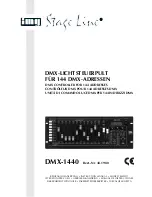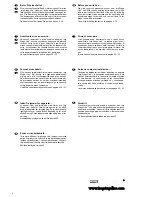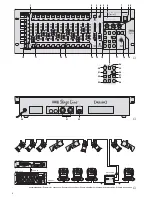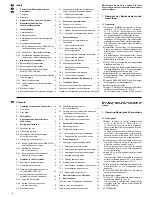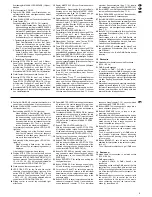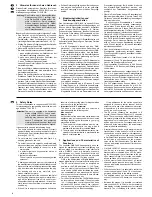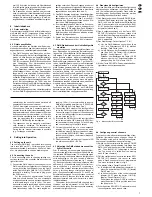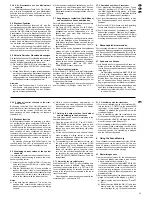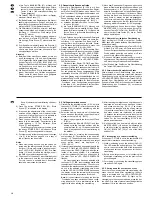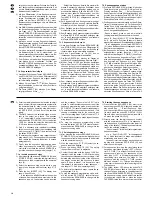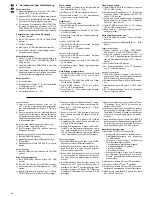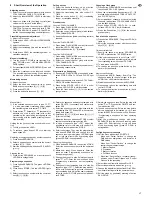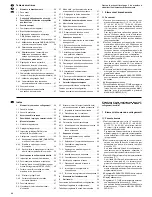
Schieberegler MANUAL CROSSFADE (16) über-
blenden
8 Ein-/Ausschalter POWER
9 Regler AUDIO SENS. zum Einstellen der An-
sprechschwelle beim musikgesteuerten Ablauf
einer Szenensequenz
10 Taste FLASH MODE zur Funktionsauswahl der
Flash-Tasten (12):
Grundeinstellung (rote LED FL. CH. leuchtet)
Beim Gedrückthalten einer Flash-Taste (12)
wird unabhängig vom Regler MASTER LEVEL
(15) der zugehörige Steuerkanal auf den Maxi-
malwert 255 gestellt, wenn diese Funktion für
den entsprechenden Steuerkanal zugelassen
ist (Kap. 4.4.2). Damit lässt sich z. B. ein
Scheinwerfer auf max. Helligkeit schalten.
1. Tastendruck (gelbe LED FL. GRP. leuchtet)
Beim Gedrückthalten einer der fünf Flash-
Tasten von links werden die zu einer Flash-
Gruppe zusammengefassten Steuerkanäle
(Kap. 5.4.1) auf den Maximalwert geschaltet.
2. Tastendruck (grüne LED SH. VAL. leuchtet)
Durch Drücken einer Flash-Taste wird der
aktuelle DMX-Wert des zugehörigen Kanals
im Display angezeigt.
3. Tastendruck Grundeinstellung
11 Anzeige STICK CTRL für den 1. und 2. Steuer-
kanal jeder Kanalgruppe; leuchtet, wenn die
Taste STICK CONTROL ASSIGN 1/2 (17) ge-
drückt wurde. Die Kanäle 1 und 2 (bzw. 13 + 14;
25 + 26 … 85 + 86) lassen sich dann mit dem
Steuerhebel MOTION CONTROL (18) einstellen.
12 Flash-Tasten; Funktionen siehe Position 10
13 Anzeige STICK CTRL für den 7. und 8. Steuer-
kanal jeder Kanalgruppe; leuchtet, wenn die
Taste STICK CONTROL ASSIGN 7/8 (19) ge-
drückt wurde. Die Kanäle 7 und 8 (bzw. 19 + 20;
31 + 32 … 91 + 92) lassen sich dann mit dem
Steuerhebel MOTION CONTROL (18) einstellen.
14 Schieberegler zur Steuerung der angeschlosse-
nen Lichteffektgeräte
15 Regler MASTER LEVEL zum Dimmen der aktu-
ellen Szene
Alle Werte der Steuerkanäle, für die eine Beein-
flussung durch den Regler MASTER LEVEL
zugelassen wurde (Kap. 4.4.2), lassen sich ge-
meinsam mit diesem Regler verringern.
16 Regler MANUAL CROSSFADE zum manuellen
Überblenden von einer zur anderen Szene; dazu
muss der Regler C.F. TIME (7) ganz nach rechts
gedreht werden (Position MAN), so dass die
grüne LED unterhalb des Reglers MANUAL
CROSSFADE leuchtet
17 Taste STICK CONTROL ASSIGN 1/2
Bei betätigter Taste leuchtet die Anzeige STICK
CTRL (11) und der 1. und 2. Steuerkanal der
angewählten Kanalgruppe lassen sich mit dem
Steuerhebel MOTION CONTROL (18) einstellen.
18 Steuerhebel; Funktion siehe Tasten STICK
CONTROL ASSIGN Positionen 17 und 19
19 Taste STICK CONTROL ASSIGN 7/8
Bei betätigter Taste leuchtet die Anzeige STICK
CTRL (13) und der 7. und 8. Steuerkanal der
angewählten Kanalgruppe lassen sich mit dem
Steuerhebel MOTION CONTROL (18) einstellen.
20 Taste TAP SPEED; durch zweimaliges Drücken
kann die Ablaufgeschwindigkeit einer Szenense-
quenz eingestellt werden [alternativ zum Regler
SEQUENCER SPEED (5)]
21 Taste ESC/SETUP zum Aufrufen und Verlassen
des Konfigurationsmenüs
22 Taste STORE/PRG zum Speichern einer Szene
(Kap. 6.1) und zum Speichern einer Szenen-
sequenz (Kap. 7.1)
23 Cursor-Tasten und zum
Anwählen
einer
Speicherbank; bei aufgerufenem Konfigurations-
menü zum Vor- und Zurückspringen auf die ein-
zelnen Parameter und im Sequenzmodus zum
Anwählen einzelner Sequenzschritte
24 Taste DELETE, um alle Steuerkanäle auf den
Wert Null zu schalten (Kap. 5.1 und 6.1) und zum
Löschen einer Szenensequenz (Kap. 7.1.2) oder
einzelner Sequenzschritte (Kap. 7.1.5); jeweils
in Kombination mit der Taste STORE/PRG (22)
25 Taste INSERT zum Einfügen von Sequenzschrit-
ten in eine Szenensequenz (Kap. 7.1.4)
26 Taste SEQUENCE zum Ablauf, Beenden oder
Programmieren einer Szenensequenz
27 Taste BANK/AUDIO; nach dem Betätigen dieser
Taste kann die Banknummer zweistellig mit den
Zifferntasten (2) eingetippt werden; im Sequenz-
modus dient die Taste zum Starten einer Sze-
nensequenz, die musikgesteuert ablaufen soll
(Kap. 7.2)
28 Taste FULL ON, schaltet alle für diese Funktion
zugelassen Steuerkanäle (Kap. 4.4.2) auf den
Maximalwert
Damit lassen sich z. B. alle DMX-Geräte auf
maximale Helligkeit schalten, ohne dass andere
Funktionen wie Schwenken, Neigen, Farb- oder
Gobo-Wechsel beeinflusst werden.
29 Taste BLACKOUT, schaltet alle für diese Funk-
tion zugelassen Steuerkanäle (Kap. 4.4.2) auf
den Wert Null
Damit lassen sich z. B. alle DMX-Geräte dunkel
schalten.
1.2 Rückseite
30 Netzkabel zum Anschluss an eine Steckdose
(230 V~/50 Hz)
31 DMX-Signal-Ausgänge
1 = Masse, 2 = DMX-, 3 = DMX+, 4 und 5 = frei
Je nach vorhandenem DMX-Eingang am ersten
Lichteffektgerät die 3-polige oder die 5-polige
XLR-Buchse an das Lichteffektgerät anschlie-
ßen; den Ausgang des ersten Lichteffektgerätes
mit dem Eingang des nächsten Gerätes verbin-
den usw.
32 Stereo-Audioeingang zum Anschluss eines Audio-
gerätes mit Line-Ausgang (0,1 – 2 V), um den Ab-
lauf einer Szenensequenz im Takt der Musik zu
steuern; beim Anschluss der Buchse wird das
interne Mikrofon (4) abgeschaltet.
9 Control AUDIO SENS. to adjust the threshold in
case of music-controlled run of a scene sequence
10 Button FLASH MODE to select the functions of
the flash buttons (12):
Basic setting (red LED FL. CH. lights up)
When keeping a flash button (12) pressed,
independent of fader MASTER LEVEL (15)
the corresponding control channel is set to
the maximum value 255 if this function has
been admitted for the corresponding control
channel (chapter 4.4.2). Thus, e. g. a projec-
tor can be set to the maximum brightness.
1st pressing of the button (yellow LED FL. GRP.
lights up)
When keeping one of the five flash buttons
from the left pressed, the control channels
combined to one flash group (chapter 5.4.1)
are set to the maximum value.
2nd pressing of the button (green LED SH. VAL.
lights up)
When pressing a flash button, the current
DMX value of the corresponding channel is
displayed.
3rd pressing of the button: basic setting
11 Display STICK CTRL for the first and second
control channels of each channel group; lights up
if the button STICK CONTROL ASSIGN 1/2 (17)
has been pressed. Then the channels 1 and 2 (or
13 + 14; 25 + 26 ... 85 + 86) can be adjusted with
the control lever MOTION CONTROL (18).
12 Flash buttons; functions see item 10
13 LED STICK CRTL for the 7th and 8th control
channels of each channel group; lights up if the
button STICK CONTROL ASSIGN 7/8 (19) has
been pressed. Then the channels 7 and 8 (or 19
+ 20; 31 + 32 ... 91 + 92) can be adjusted with the
control lever MOTION CONTROL (18).
14 Sliding control to control the connected light
effect units
15 Fader MASTER LEVEL to dim the present scene
All values of the control channels for which an
influence by the fader MASTER LEVEL has
been admitted (chapter 4.4.2) can be reduced in
common with this control.
16 Crossfader MANUAL CROSSFADE for manual
crossfading from one scene to another; for this
purpose the control C.F. TIME (7) must be turned
to the right stop (position MAN) so that the green
LED below the crossfader MANUAL CROSS-
FADE lights up
17 Button STICK CONTROL ASSIGN 1/2
With the button activated, the LED STICK CTRL
(11) lights up and the 1st and 2nd control channels
of the selected channel group can be adjusted
with the control lever MOTION CONTROL (18).
18 Control lever; function see the buttons STICK
CONTROL ASSIGN items 17 and 19
19 Button STICK CONTROL ASSIGN 7/8
With the button activated the LED STICK CTRL
(13) and the 7th and 8th control channels of the
selected channel group can be adjusted with the
control lever MOTION CONTROL (18).
20 Button TAP SPEED; by pressing twice, the run-
ning speed of a scene sequence can be adjust-
ed [alternatively to the control SEQUENCER
SPEED (5)]
21 Button ESC/SETUP for calling and exiting the
configuration menu
22 Button STORE/PRG for storing a scene (chap.
6.1) and for storing a scene sequence (chap. 7.1)
23 Cursor keys
and
for selecting a memory
bank; to advance and reverse to the individual
parameters with the configuration menu called
and to select individual sequence steps in the
sequence mode
24 Button DELETE to set all control channels to the
value zero (chapters 5.1 and 6.1) and to delete a
scene sequence (chapter 7.1.2) or individual
sequence steps (chapter 7.1.5); each combined
with the button STORE/PRG (22)
25 Button INSERT to insert sequence steps into a
scene sequence (chapter 7.1.4)
26 Button SEQUENCE to run, to stop, or to pro-
gramme a scene sequence
27 Button BANK/AUDIO; after actuating this button,
a two-digit bank number can be entered with the
numerical keys (2); in the sequence mode, the
button serves to start a scene sequence for
music-controlled run (chapter 7.2)
28 Button FULL ON, sets all control channels ad-
mitted for this function to the maximum value
(chapter 4.4.2)
Thus, it is possible to set e. g. all DMX units to
the maximum brightness without influencing
other functions like panning, tilting, change of
colour or gobo.
29 Button BLACKOUT, sets all control channels
admitted for this function to the value zero (chap-
ter 4.4.2)
Thus, it is possible to blackout e. g. all DMX units.
1.2 Rear panel
30 Mains cable for connection to a mains socket
(230 V~/50 Hz)
31 DMX signal outputs
1 = ground, 2 = DMX-, 3 = DMX+, 4 and 5 = not
connected
Depending on the existing DMX input at the first
light effect unit, connect the 3-pole or the 5-pole
XLR jack to the light effect unit; connect the out-
put of the first light effect unit to the input of the
next unit etc.
32 Stereo audio input to connect an audio unit with
line output (0.1 – 2 V) to control the run of a
scene sequence to the rhythm of the music;
when connecting the jack, the internal micro-
phone (4) is switched off.
5
GB
D
A
CH
Summary of Contents for DMX-1440
Page 53: ...53 ...

